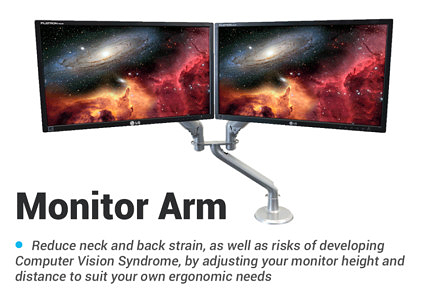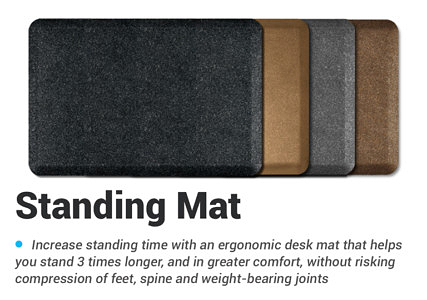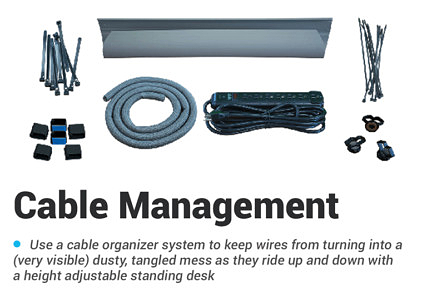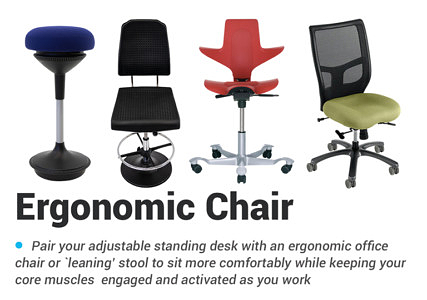Seville Airlift 360 Keyboard Tray Review
- Lab tested
Like most reviews sites, our editorial staff and laboratory testing expenses are partially offset by earning small commissions (at no cost to you) when you purchase something through those links. Learn More

Overview
| Review Summary |
From dimensions to features, Seville has numerous issues of consistency between what is advertised and what is sold. Most critically, it does not offer the claimed -22° of keyboard tilt. In fact it doesn’t offer ANY negative tilt, only a positive tilt (the wrong rotation range, useful only to gamers who lean way back in their chairs) and is therefore merely a sliding keyboard tray, not an “ergonomic” keyboard tray. It needs more space under a desk than it says on the website and in the manual, resulting in the tray poking out proud of the user edge of the desk a couple of inches when fully retracted (requiring re-installation to remedy, if you have the room under your desktop to do it). The sliding mechanism is extremely crude and stiff. The entire mechanism is extremely “floppy” and the tray droops on the left side with even moderate weight of the user’s arms resting on their keyboard. |
|---|---|
| Best Use |
If you are on a tight budget, strictly need height adjustment, and don’t mind going without ergonomic flexibility. |
| MSRP / List Price | $54.99 |
| Street Price | Scan for available discount deals |
| Warranty |
1 year |
| Adjustment Range |
Keyboard tilt: +22° |
| Weight Capacity |
5 lbs |
| Dimensions |
Keyboard tray: 25″ x 9.8″ x 0.6″ |
| Product Weight |
9.9 lbs |
| Competition | Top-Rated Ergonomic Keyboard Tray Reviews |
| User Reviews | See reviews on Amazon |
| Where to buy |
Buy on Amazon |
Rating
| Ease of Assembly | |
|---|---|
| Stability | |
| Reliability | |
| Ergonomics | |
| Innovation | |
| Value | |
| Positives | It is hard to find a cheaper keyboard tray. You can pivot the tray 360°, which is a great feature if you need it (most users will want their keyboards perfectly parallel to their desktops, however). The keyboard tray platform is spacious and should accommodate most common keyboards and still leave at least 5” of lateral movement area for a mouse. |
| Negatives | There’s no negative tilt despite the claimed -22°, which eliminates one of the tray’s two ergonomic features. Inconsistent dimensions can make it difficult to tell if the tray will actually work on an individual desk (see our correct measurements above). Component quality is shoddy, resulting in a very rough retraction-extension sliding action, the tray drooping on the left side, and an extreme amount of “floppiness” in the entire mechanism. The warranty is only one year, but frankly it feels like the entire mechanism is likely to fall apart before that year is even up, as some users have reported in verified user reviews had occurred to them. Height adjustment is awkward. There is no fence to keep a wireless mouse from careening off the tilted tray. |
Bottom Line
[Editors’ Note – This product is no longer available from the manufacturer. We will keep this review up for future reference and comparison.]
Review
The main goal of an adjustable keyboard tray is to fix two common ergonomic problems, elbow flexion and wrist flexion. Elbow flexion is holding the elbows at too sharp an angle. This is where height adjustability helps. Wrist flexion is bending the wrists too far back toward the forearm. This is where negative tilt helps.
On description alone, the Airlift 360 should solve both of these problems. It is height adjustable and claims up to -22° of negative tilt. In practice, there are some big issues.
Wherefore Art Thou Negative Tilt?
Seville claims this tray will go from positive +6° to negative -22° of tilt. To put this in context, most conventional keyboard trays (i.e. ones that have been on the market for decades, originally designed only for fixed-height desks) have a tilt range of +10° to -15°. We were initially suspicious of Seville’s claimed range because no photos on the product page show the tray with negative tilt.
After installing it, we could not find any way to get the tray to achieve any negative tilt whatsoever, much less 22°. However, the tray can achieve about 22° of positive tilt. We think Seville’s engineers and marketers fell into the same trap that many users do and flipped negative/positive tilt. This also means not a single one of them has any background in ergonomics whatsoever. Rather, this is a classic example of a copycat, knock-off manufacturer in China getting something fundamental ludicrously wrong.

This is perhaps the single most important concept that many users, and even salespeople and websites that sell keyboard trays, get reversed in their minds, and it’s easy to understand why this happens. The very word “negative” sounds counter-intuitive. But, in fact, it’s a negative tilt, as shown in the photo on the right, above, that you want to achieve with an ergonomic keyboard tray. The only application for positive tilt is typically for gamers who want to lean way back in their chairs and still be able to see and reach their keyboards.
In general, keyboard trays allow you to tilt the edge of your keyboard that’s closest to the user up, bringing it into a negatively-inclined position from the perspective of where your wrists are resting on the user edge of the keyboard. While this may depart from old-school, pre-ergonomic keyboard design (pop-up tabs on many keyboards used to let you elevate the back—a humongous ergonomic no-no) it’s actually ergonomically proper to tilt the keyboard the other way.
It’s only by placing the keyboard at a negative tilt that wrist flexion—and consequent squeezing of the carpal bones that surround the nerves and blood vessels that pass through them—can be neutralized. Those adding an adjustable keyboard tray to a treadmill desk will need even more negative tilt than at a standing desk. We’ve never been able to figure out how the computer industry started down this path of tilting keyboards in exactly the opposite direction as is ergonomically correct; the myth has persisted for decades and millions of computer users are still unaware.
After a close look at the Airlift 360 bracket, the design of the bracket groove for movement simply doesn’t allow the tray to move in a fashion to put a negative tilt into the tray.
What’s almost as shocking to us is that of the 652 user reviews this product received on Amazon at the time of this writing, not a single one commented on the missing negative tilt! This either means that they were only really looking for a “retractable keyboard drawer” and never planned to use the tilt, or they are all blissfully ignorant of the ergodynamics that go into designing an active workstation. Most likely both.
This is one reason why we always caution our readers to put very little faith in user reviews on Amazon. Clearly, not a single one of these users has ever compared this product to an actual ergonomic keyboard tray. We’ve tested dozens of keyboard trays over the years here at WorkWhileWalking and can state with confidence that whether willful or not, this manufacturer is committing a degree of false advertising with the Airlift 360 that should get them booted off Amazon.
Which Measurement is the Right One?
Most adjustable-height desks have a crossbar under the desktop to add stability, which significantly reduces the amount of available depth for the glide rail of an adjustable keyboard tray. Because of this, one of the most important measurements for an adjustable keyboard tray that will go on an adjustable-height desk is the length of its rail (for more on adding an adjustable keyboard tray to a standing desk, check here).
Unfortunately, this critical measurement is tough to pin down for the Airlift 360. The Seville website says you need 14” of space under the desk. The installation manual says you need 14.1” of space under the desk, but then a few lines later lists the length of the rail as 14.5”, meaning that by Seville’s suggestion you could install the product with nearly half an inch of the bracket sticking out from the desk edge.
We measured the rails at 15 5/16”, meaning if we bought the tray based on Seville’s claim of 14” and had exactly 14” of free space under a desk, it would stick out nearly an inch and a half from the desk edge. And indeed quite a few user reviews on Amazon noted that they installed their trays as instructed and wound up with their keyboard sticking out a couple of inches proud of the front edge of their desks when fully retracted.
These differences are a massive issue. The difference between the 14” claimed by the Seville website and the 15 5/16” we measured might make this product completely unusable for your desk. It’s also fair to question the quality of a product when there are so many different dimensions being tossed around.
It boils down to making sure you measure carefully. A rail length of 15 5/16” is smaller than many adjustable keyboard trays, but also means the Airlift 360 will not fit on many adjustable-height desks. It is also much longer than the rails on other keyboard trays we’ve reviewed that are truly designed for sit-stand desks with crossbar interference, such as the SteadyType Exo (8”), iMovR Trackless (9.4”), and Humanscale Float (12”).
If you’re having trouble making a keyboard tray work with a standing desk, one option is this adapter kit we reviewed that helps bypass standing desk’s crossbar.
Installation
The installation process was minimal, with only four steps. The steps were easy and fast until the final step of fastening the brackets to the bottom of the desk, which was difficult for a few reasons. First, it’s hard to hold the whole thing in place by yourself; you might want to get a friend to help you.
The two rails of the bracket move somewhat independently, so you have to make sure both are in the correct place, plus at perfect right angles to the desk and perfectly parallel to each other. Second, the weight of the tray platform has to be held up to align the rails with the bottom of the desktop. The manual suggests using a screwdriver to manually drive the screws in, which would be quite tough. We used a cordless drill and pre-drilled the holes because it was so awkward to hold the rails in place.
Keep in mind that we installed the tray on an upside-down desk, and we’d highly recommend that if you’re able to get your desk flipped over. On an upright desk, fastening the brackets to the bottom of the desk would be even more difficult. The upside of this method of installation is that the rails were very stable as we screwed them into the desktop.
The screws that hold the keyboard tray to the bracket are short. There were no issues with our installation and moving the tray around for testing, but it seems like these will not hold well with use, and reviews from users overwhelmingly pointed to this as a problem with regular use over just a short period of time.
Particularly with cheap particle board desktops found on many Chinese-manufactured standing desks these short wood screws would easily rip out with nominal downward force on the keyboard tray “lever.” If you have the desktop thickness to enable using longer screws we’d recommend using at least 1”-long screws in place of the ones provided.

There are other product quality issues as well. The wrist rest is mostly hollow, plus it feels cheap and likely to crack after minimal use. We were unable to get it clean from wiping off dust straight out of the packaging, so it will definitely collect dust, skin oils, and other things usually found in a workspace. As wrists rests go this is the poorest quality one we’ve ever seen.
From just a few minutes of testing, adjusting, swiveling, etc. there were several parts of the bracket where paint was already rubbing off. It is not the high-quality powder-coat paint we are used to seeing on ergonomic keyboard trays, but it also isn’t a $200-$600 keyboard tray. When it comes to gliding parts, though, like the rails, it’s rather inexcusable to slip the hard, glossy finish of a good powder coat paint job.

The Airlift 360 comes with a short, one-year warranty. Considering the issues we saw and read about from users, we don’t have a great deal of confidence it will last much longer than that.
Ease of Use
The Airlift 360 pivots completely around the bolt in the mounting bracket, allowing you to have at other-than-parallel angles to your desktop. On standing desks wider than 48” is may also allow you to “stow” it completely under the desk by rotating it out of the way—similar to how the iMovR Stowaway Keyboard Tray works. The bracket doesn’t stick down very far from the rails, giving your knees plenty of space.
Adjusting the height and tilt of the tray was not as simple. The adjustment lever is under and behind the tray, very awkward to reach. Adjustments are performed by loosening and tightening the lever, similar to the quick release hub on a bicycle wheel. The bracket naturally springs upward when the lever is loosened, making it especially difficult to get the tray into a lower height position. It requires pushing and holding the tray downward while reaching around the side to access the lever. While the swivel feature is great, it loses some luster when you have to loosen the knob, wrestle the tray into the correct position, and then tighten the knob in order to swivel it under the desk.

The swivel bracket has only one attachment point, which leaves plenty of space for play in the tray in all directions. Despite the wobble, its most stable position is when applying slight downward pressure like typing.
The tray itself is spacious and made from solid plastic material. It’s 25” long, which is enough space for most full-sized keyboards and a mouse (note: if you have an extra-wide keyboard like the very popular Microsoft Natural 4000 you may find having only 5” of lateral mouse movement a bit too constraining). At 9.8” deep, it has enough space for most popular keyboards.
There is no fence to prevent a wireless mouse from falling off the tray when tilted or bouncing off the tray if it’s jostled. When you combine the wobble and the awkward method of adjusting the tray, your mouse falling off could be a real issue. Not having this feature or an independently-adjustable “lilly pad” mouse platform, your mouse wouldn’t stay on the tray well if the Airlift 360 actually had 22° of negative tilt capability. Or even 10°. So this will perhaps be a moot issue for most users.
The Takeaway
On paper, the 22° of negative tilt should allow for plenty of ergonomic positions and the 14” requirement under the desk should make it an option for some of the adjustable-height desks that can accommodate such a deep draft. Unfortunately, neither of these features show up in reality.
That said, this is an adjustable keyboard tray for under $60, meaning there’s definitely some value present since it will at least allow you to adjust the height at which you’re typing and tuck your keyboard under the desk when you need to. It is in no way, shape, or form, however, an “articulating ergonomic keyboard tray.” If that’s what you’re in the market for (and we hope you are for the sake of your wrists and elbows) please check out the many other better options in our comprehensive round-up of lab-tested ergonomic keyboard tray reviews.
What to do when you want to take a conventional keyboard tray off your old fixed-height desk and transfer it to your new standing desk instead? A common issue that people have when installing keyboard trays on standing desks is being incompatible with the crossbar under adjustable-height desks. iMovR’s Keyboard Tray Standing Desk Adapter Kit offers an easy workaround to this problem without sacrificing any adjustability or stability






0 Comments
Leave a response >